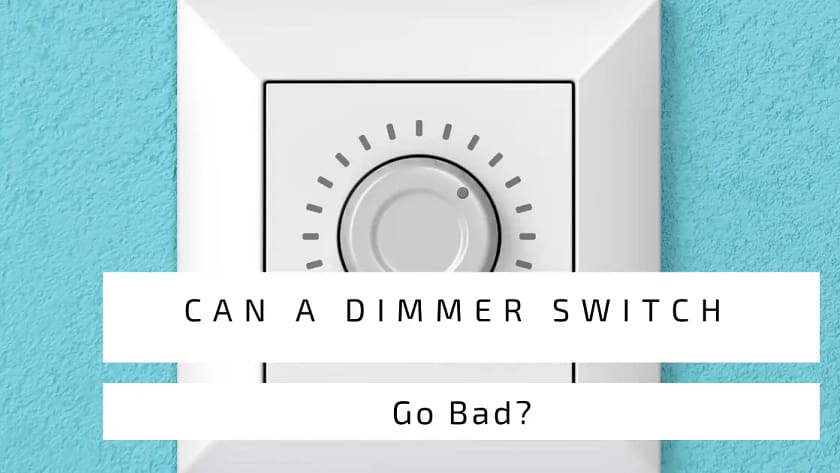Having a dimmer switch allows you to save money on electricity and create mood lighting. Furthermore, because dimmers do not require any particular maintenance, these devices are simple to install and maintain.
They also can last a long period (15 years) when your switches are of high quality. Cheap dimmers can burn out and may not survive for many years.
Like any device, a dimmer can go bad. Over time, the parts in your switch can wear and tear, causing them to no longer function the way they should. Many problems, like loose wires, old age, or overuse, can occur. Below, I will summarize the reasons your dimmer switch stop working.
Dimmer switches have gone a long way since their conception, with many fantastic new additions to them, but they still wear out and need to be replaced after a while. One problem is dimmers overload, which happens when the current entering the switch is too high.
Dimmer Overloads And Loose Wires
The temperature of a typical dimmer switch should be around 60°C (140°F). Some allow for a maximum temperature of 90°C (195°F). However, this is the internal temperature of the components in the switch, not the external area you are touching.
Because of this internal heat, dimmers can control the current running through the fixture and modify their brightness instantly.
A semiconductor that behaves as a transistor is used in modern dimmer switches to do this. As a result, your dimmers get hot inside, using the metal heat sink to mitigate the effect.
If your dimmer is hot to the touch, then this can be a sign of overloading. Overloading results from the fixture wattage being higher than the dimmer watts.
This uneven balance can create burnout, causing your dimmers to go bad. Another reason for hot dimmers is loose wires; this can cause dangerous problems like fires. To be safe, examine the connections connecting the outlet and repair any loose wires if the dimmer switch appears to be extremely hot.
Buzzing Dimmers
Buzzing is another sign your dimmers are going bad. This problem occurs if there is a defect in the switch mechanism or in the light bulb.
An older, dimmer switch operates by hindering the current passing through the switch to the fixture using a variable resistor. Hence, when you dim your light, the brightness decrease.
However, it takes more electricity to redirect the current through the resistor. This leads to the resistor overheating, causing a buzzing sound or, in the worst-case burnout.
Besides defective dimmer components, the light bulbs can cause a buzzing sound. Changing the bulbs can stop the buzzing. If the noise doesn’t subside, then you may need a different type of bulb-like swapping incandescent or CFL to LEDs.
LED Compatibility Issues And Old Age
Most people believe all dimmers work with dimmable LED bulbs, but that is untrue. Fortunately, there are signs to tell if your dimmers are experiencing incompatible problems. These include buzzing, flicking, or humming, which most homeowners will mistake for their dimmers going bad.
Other signs are dropped out where your lights cut out when it reaches the bottom of the dimming range. Pop on: the lights become brighter at a certain point. Lastly, unresponsive when your lights don’t react to any adjustments to their brightness.
Therefore, if you are experiencing these problems, then turn off the lights, chances are your dimmers are fine, and the pair isn’t a match.
The troubleshoot for dimmer incompatibility involves double-checking to see if you have not exceeded the maximum wattage of the dimmer and if there is an incompatible problem. Then, replace the bulb with a brand that is on your dimmer compatible list.
Old age is pretty self-explanatory. So if you have had your dimmers for 10-15 years and have noticed they no longer work, it is because of old age. The best way to fix this is to purchase a new dimmer.
How Many Watts Can A Dimmer Switch Handle?
Simple answer: it depends on the dimmer. Every dimmer switch is different and comes in a wide range of wattage ratings to cater to every household. Thus, it is important to know the total watts of the dimmer before buying.
The most common ratings are 150 watts, 300 watts, 1000 watts, and 600 watts. A quick tip: if you are planning to dim two 100 watts bulbs, it is best to have a 300-watt dimmer.
Dimmer Wattage Calculation
- Multiply the number of fixtures by the wattage rating of each fixture.
- Multiply the result by 125 % (continuous load).
- Round up to the next dimmer wattage rating.
A 400W dimmer switch, for example, should only have 40W of LED bulbs connected to it, which equates to ten 4W bulbs.
Dimmers have both minimum and maximum loads and here’s why.
Minimum Loads
Dimmers have minimum loads because they cater to LEDs that do not draw enough current to keep the dimmer’s switching elements closed. Compared to incandescent, which have a larger minimum load with a higher wattage than LEDs. So, dimmers may need multiple LED lights to meet the minimum load requirement.
Maximum Loads
Dimmers have a maximum load to prevent homeowners from surpassing it. Adding too many fixtures to your dimmer can cause premature failure, buzzing, or flicking.
A good rule of thumb is to leave 100 watts below the limit for inrush current. Inrush current is the sudden bolt of current for a short period during the initial start-up that transcends the steady-state current value.
What To Do If Your Dimmer Switch Is Going Bad

Dimmers can burn out if you have exceeded their maximum loads, old age, LED incompatibility, and loose wires. If you are unsure of the problem then, you can always call an electrician.
He can identify the problem and advise on whether you need to replace the dimmer. Dimmers like Philips Hue can control up to 50 fixtures, so this brand is a great place to start. However, it is on the pricey side, and you may need additional devices like the Hub.


